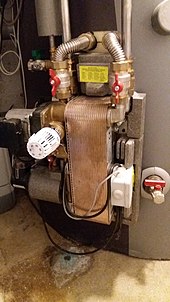Fresh water station
A fresh water station is used to heat water, e.g. B. for showering, bathing or washing in order to be able to generate warm household water with a stratified charge storage tank installed .
A fresh water station is required in order to be able to use the heat from the heating water from within the storage tank to heat the drinking water. With a heat exchanger from the hot water storage tank, either via a plate heat exchanger or via a heating coil in the storage tank, warm household water is generated using the continuous flow principle when water is withdrawn. This separates the drinking water from the heating water circuit, since the water within the stratified storage tank serves as heating water for room heating.
As a rule, the water obtained in this way is then fed into the hot water circulation line and reaches the taps via this route. The risk of Legionella formation is practically excluded, as no warm drinking water is stored.
If the fresh water station is integrated into the storage tank, it is also called a fresh water storage tank .
literature
- Expertise in installation and heating technology , Europa Lehrmittel, 5th edition from 2014, ISBN 978-3-8085-1527-3 , pp. 564-565
